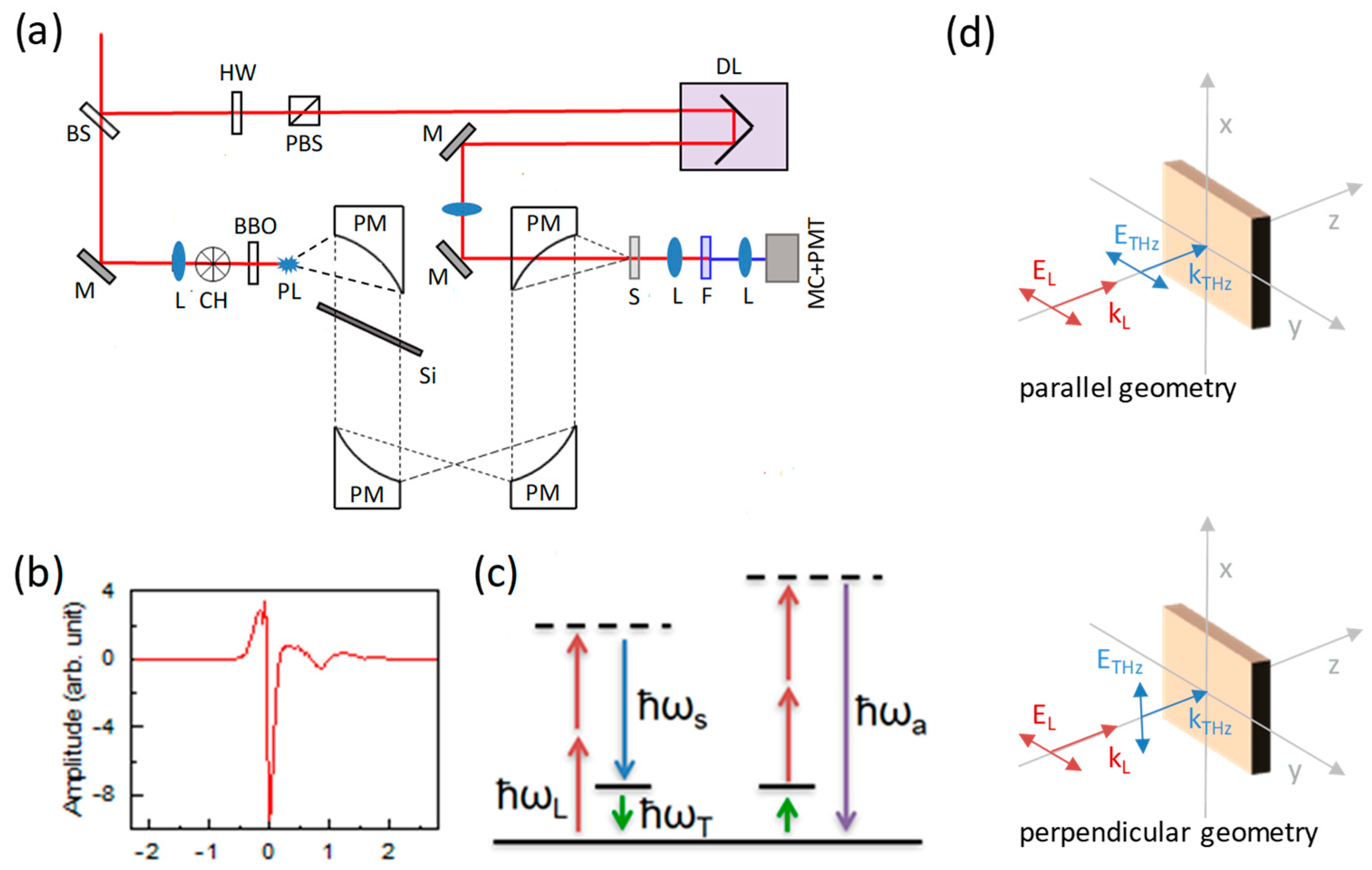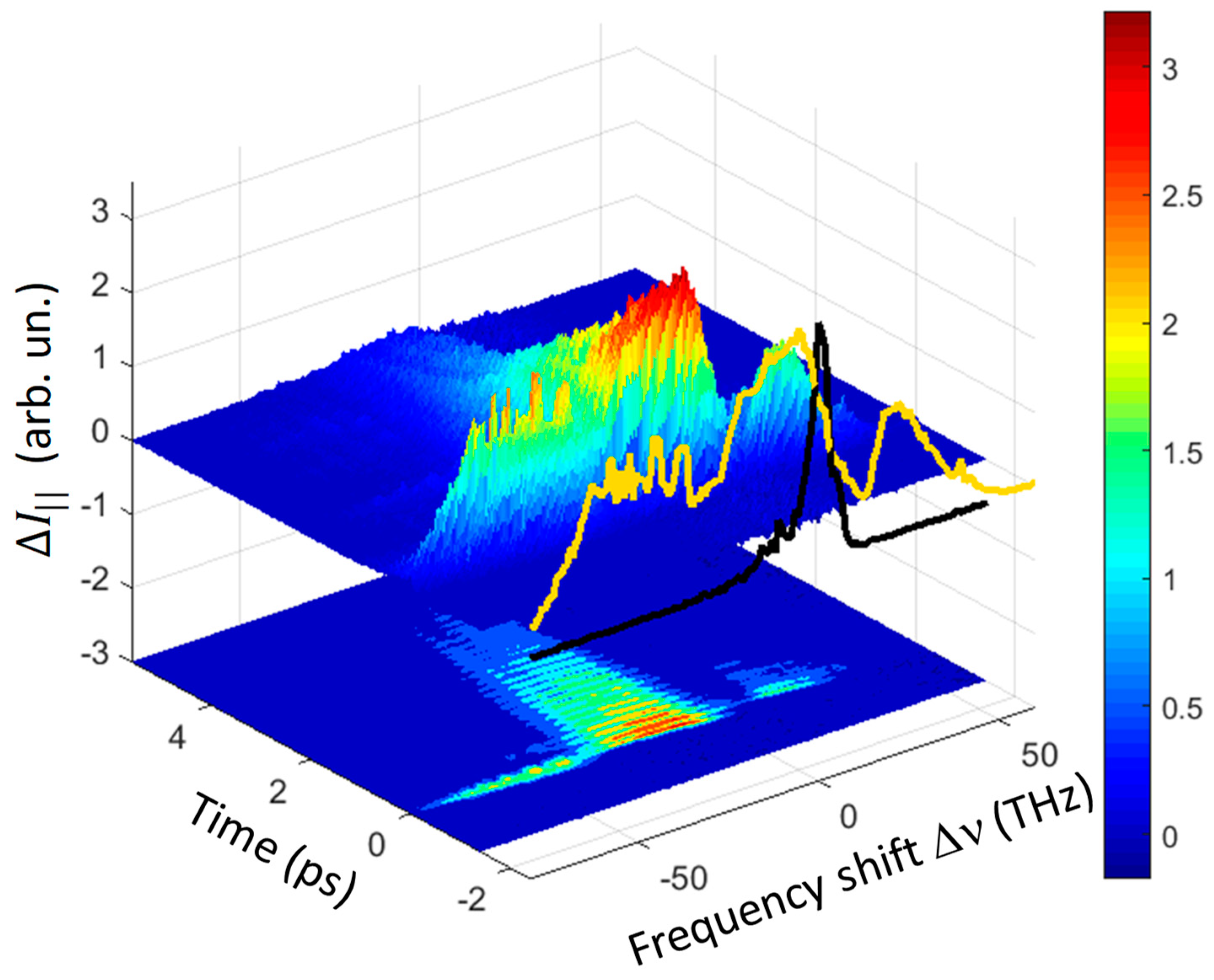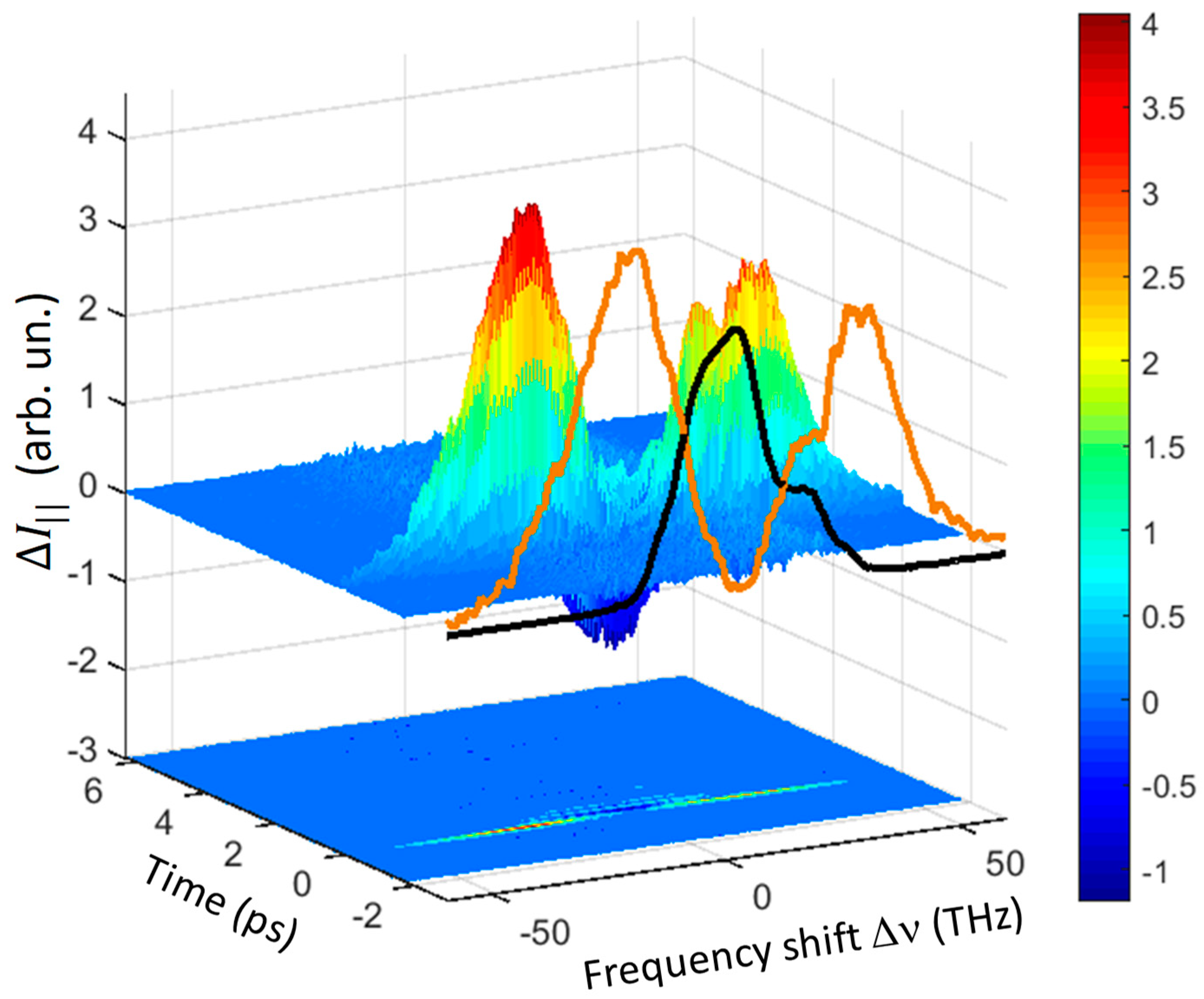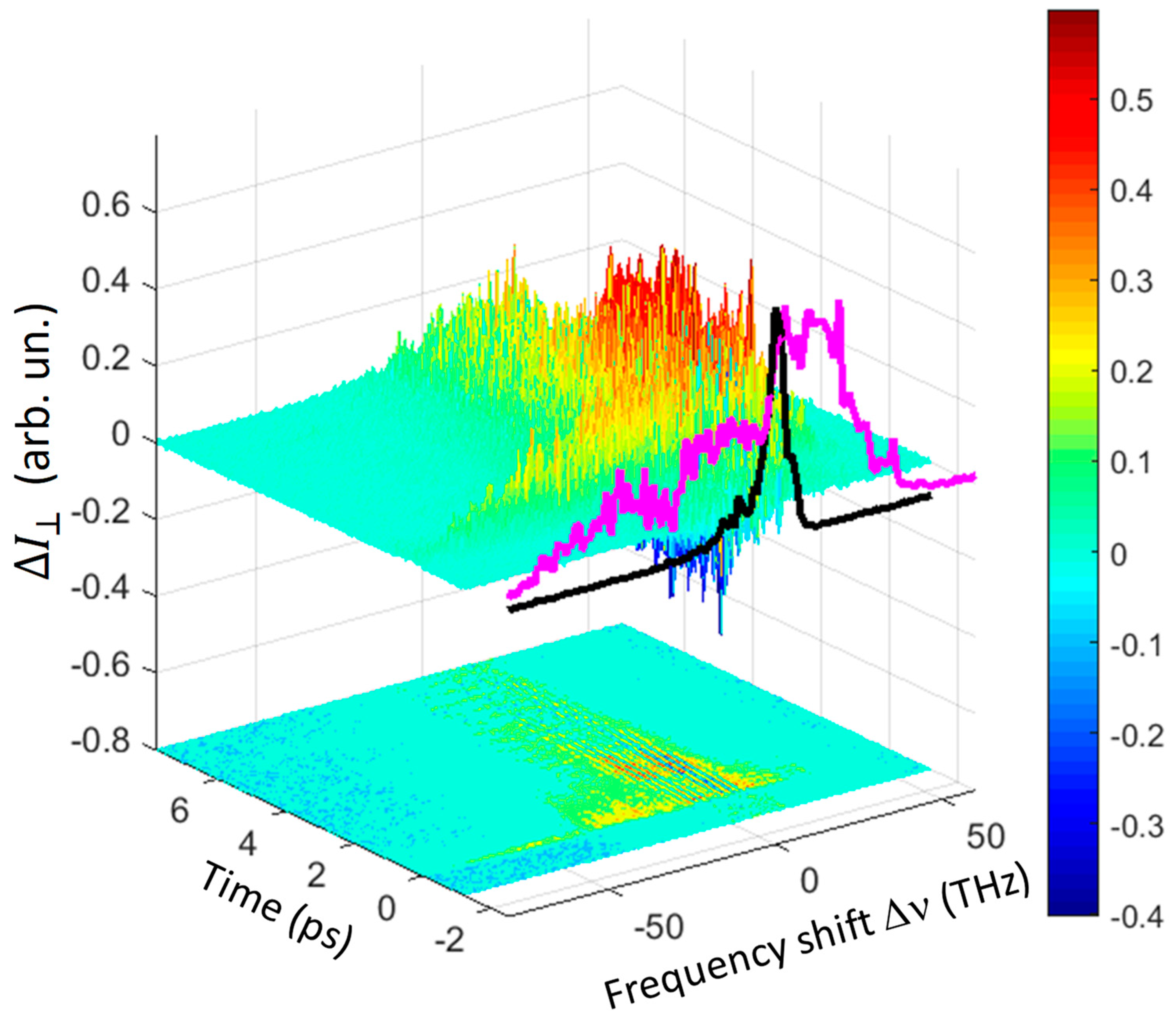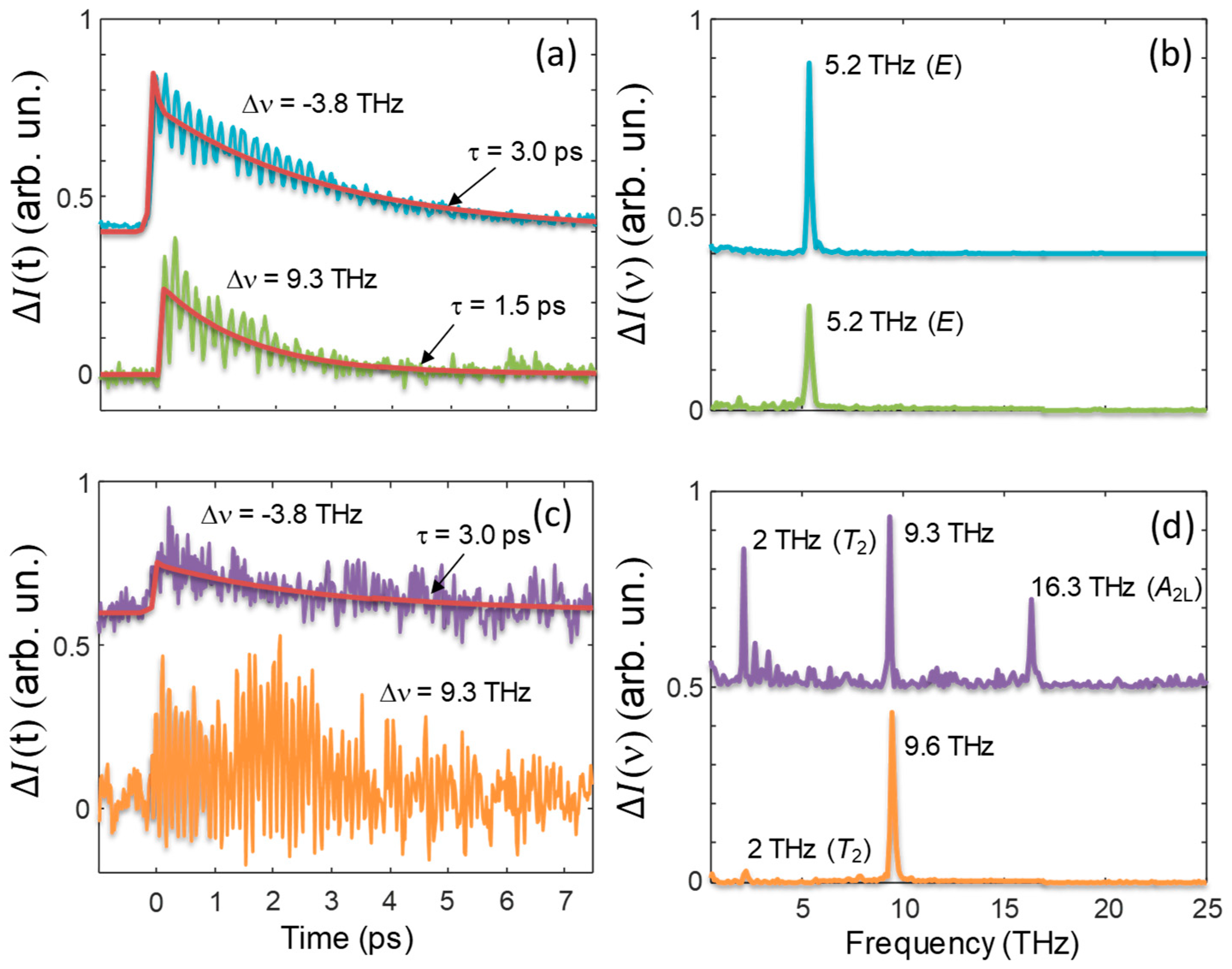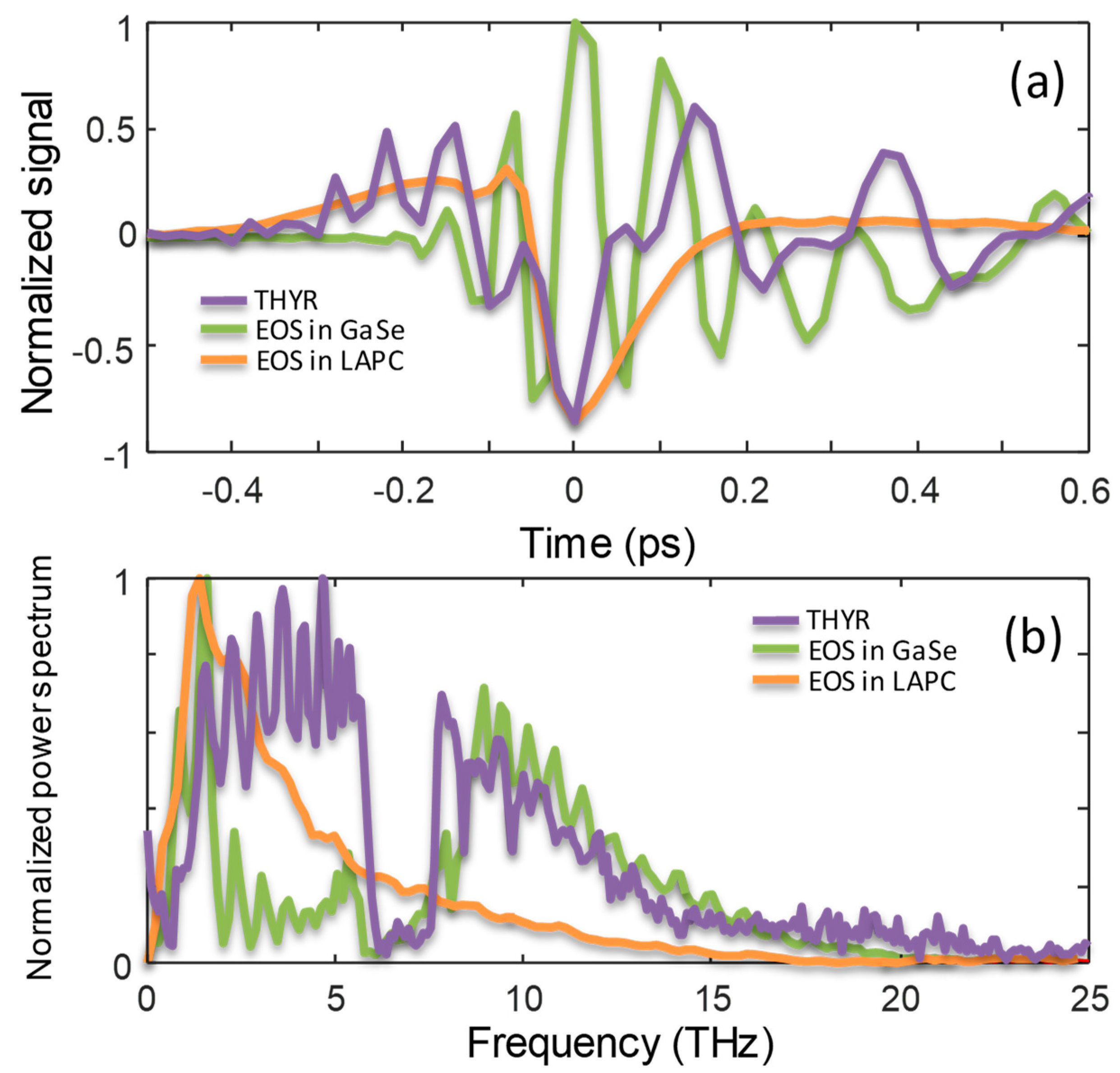1. Introduction
The Terahertz electromagnetic spectrum ranges in the frequency window from ~100 GHz to ~30 THz, i.e., in between the microwave and the far-infrared domains. The band including these frequencies was historically termed the ‘THz gap’, due to the relative difficulty of generating and detecting this elusive electromagnetic radiation. Taking advantage of the latest development of femtosecond laser technology, today available table-top THz spectrometers are becoming more and more widespread, it is now possible to generate almost single-cycle THz pulses—i.e., electromagnetic pulses with only few periods duration (~0.1 ps at 10 THz). On the other hand, a great progress for the detection of THz pulses has been achieved by the introduction of the so-called electro-optic sampling (EOS) technique, which uses part of the laser pulse generating the THz field to sample the latter. This advancement has led to the development of the so-called THz time-domain spectroscopy (THz-TDS) [
1]. By means of the latter the complex optical parameters (optical conductivity, refractive index or dielectric function) of a target material are obtained by measuring the THz waveform in time-domain through EOS. Then, the recorded THz waveform is fast-Fourier-transformed in the frequency domain. Finally, the so obtained spectrum is compared with the spectrum acquired in a suitable reference sample [
2,
3]. By means of this procedure the real and imaginary parts of the optical parameters in the investigated spectral range are obtained without the need of Kramers–Kronig-based numerical methods [
4] or in combination with the latter for improving the thickness estimation of thin films [
5].
With the advent of high-power THz sources, the last decade has witnessed a rapid growth of reports on the nonlinear interaction between intense THz pulses and matter that has paved the way to the topical field of ‘THz nonlinear optics’ [
6,
7,
8,
9,
10,
11,
12,
13,
14,
15]. Recently we have demonstrated a new nonlinear optical effect in crystalline quartz (α-SiO
2) that we have named THz hyper-Raman (THYR) [
16]. It makes use of femtosecond infrared (IR) pulses and intense, sub-ps, broadband THz pulses to generate a four- and five-wave-mixing (FFWM) in the investigated material. The generated pulse has a central frequency at the (anti-)Stokes side of
for the four-wave-mixing and
for the five-wave-mixing, where
and
are the optical and THz central frequencies, respectively. The generated THYR signal is recorded as a function of both the wavelength and the temporal delay between the IR and the THz pulses.
The three-dimensional (3D) spectrum of the THYR signal may bring much information on the investigated material or on the waveform of the THz pulse. When material resonances lie in the THz band of the THYR signal these show up in the THYR 3D-spectrum as temporal oscillations. The latter may be solved in the frequency domain by applying a numerical fast Fourier transform (FFT). In the absence of resonances, the THYR 3D-spectrum may be used under some circumstances for a phase-sensitive detection of the THz optical field, as we have demonstrated in crystalline GaSe [
17].
In this work we review our recent results on THYR in different crystals. In the following we will provide with a detailed description of the THYR technique, including a complete theoretical analysis, so to highlight all the potentialities of this new tool. This article is not meant to be a comprehensive review on the very recent and rapidly growing field of nonlinear optics in the THz regime. For a comprehensive review on the latter we remind to Ref. [
10].
2. Theory
In this section we provide a detailed theory of the THYR effect. In the following derivation we will assume that the material thickness is negligible, i.e., we will not solve the Maxwell-equations for the propagating beams and we will not discuss the phase matching conditions of the process.
Let us consider two input laser pulses, each with a spectral interval of frequencies spanning frequencies
in the visible range and
in the THz range. Among several other mixing terms, they will induce a nonlinear polarization oscillating at the four-wave mixing frequencies
having an amplitude given by:
where
is the complex conjugate of the field, and
is the third-order susceptibility tensor. To describe completely the THYR signal, we need to include higher order effects involving multiple THz photons. The amplitude of the optical nonlinear polarization generated in these processes (five-wave mixing) is given by:
The complex electric field of the two input laser pulses can be written:
where we have made explicit the spectral distribution for the two pulses.
are the i-th components of the complex field amplitudes at
and
, and Δ
t is the temporal delay between the THz and IR pulse (for Δ
t > 0 the THz pulse is anticipated).
2.1. THYR in the Presence of a Strong Second Harmonic Signal from the Fundamental Beam
According to Equations (1) and (2), the THYR optical field is proportional to the following combinations for the Stokes and anti-Stokes components, respectively:
where, for simplicity, we have omitted any reference to the tensor and vector character of the involved quantities. In the presence of a local oscillator (LO) second harmonic signal (SHG),
, generated by the fundamental beam alone and driven by the second-order constant
, we have interference effects that lead to the following expression for the total measured intensity.
where
indicates the real part of the complex field. Moreover, for the sake of clarity, we have omitted the frequency dependence and neglected fast oscillating terms that average at zero on a THz optical cycle.
and
are the intensity of the fundamental and THz beam, respectively. In the latter equation we have assumed that
,
, and
are real. This is true if we are far from material resonances, as we will show in the following for the case of GaSe, otherwise Equation (5) becomes a bit more complicated although qualitatively the same.
Given our differential detection scheme, we actually measure the following quantity
where the term
vanishes since it is independent on the THz field. In the latter we have also neglected the term
that is of higher order compared to
. The third term of Equation (6) is interesting for the application in THz detection since it is proportional to the THz field and hence, under some circumstances, it may enable a phase-sensitive detection of the latter. When
is negligibly small or the LO-SHG can be strongly reduced by using a specific geometry that spoils the optimal phase matching condition, we are left only with the terms
and
that allow a THYR spectroscopy of the investigated material as better explained below.
2.2. Semiclassical Model of THYR SPECTROSCOPY
In this section we calculated the relationship between the non-linear susceptibilities and , and the macroscopic material constants that account for the induced dipole moment, the linear hyper-polarizability, and the hyper-Raman susceptibility tensor. This derivation will provide the foundation of the THYR time-domain spectroscopy (THYR-TDS).
In general, the material polarization is written:
where the summation rule on repeated indices is assumed, and the polarization is broken in its field-dependent and non-dependent components,
and
, respectively.
is the i-th component of a possible permanent dipole of the material,
is the material hyper-polarizability, and
is the susceptibility tensor accounting for the hyper-Raman effect. In the latter equation, we have also omitted the terms of
oscillating at
and
since they eventually give rise to spectral components out of the detected range. If
,
, and
are not constant in time, but modulated because of the variation of an oscillator material degree of freedom
, we can approximate the first-order variation of
as:
where we have kept only the terms proportional to
. We note that, even in absence of a permanent dipole moment,
may be different from zero, giving rise to a coupling with IR-active modes. The oscillator degree of freedom (i.e., the deviation from the interatomic equilibrium distance in a single ion-chain) is the solution of the classical equation for a driven damped oscillator whose solution is given by:
In the latter
F(
t) is the driving force, while
is given by:
where
is a possible non-resonant contribution, Ω is the proper frequency of the resonant mode,
is the amplitude of the resonant term, and
is the damping constant. The driving force
F(t) is a deterministic electromagnetic force associated with the usual dielectric energy
through the relation
. This expression contains several terms, which are oscillating at different frequencies. Let us retain only the terms that oscillate at frequencies that are resonating with low-energy proper frequencies, i.e., terms oscillating at
and 2
. We may then write:
By inserting Equation (11) in Equation (9) we obtain the modes resonant at
and 2
:
By replacing the expression of
q(t) given by Equation (12) in Equation (8) we may calculate
and, eventually, obtain its Fourier components:
where we have neglected terms that oscillate at frequencies around
and not around 2
is the Dirac function that accounts for the energy conservation leading to the Stokes (
) and anti-Stokes (
) components of the spectrum. One important result of Equations (13) and (14) is the presence of the oscillatory terms
and
that predict oscillations of the THYR signal as a function of the delay Δt. This prediction may be used for solving in the time-domain the material resonances, thus allowing a THYR time-domain spectroscopy (THYR-TDS) as the nonlinear analog of the THz-TDS.
Finally, by comparing Equations (1) and (2) with the latter, we obtain the following relationships for the nonlinear optical susceptibilities:
We note that
and
couple to IR- and Raman-active modes, respectively. On the other hand,
is a fourth-rank tensor characterized by selection rules that are different and may include those driving IR and Raman processes [
18]. Therefore, the THYR technique may allow a simultaneous investigation of low-energy excitations that are complementarily present in IR and Raman spectra.
3. Materials and Methods
The experimental set-up is shown in
Figure 1a. A Ti: sapphire amplified laser (not shown) delivering at 1 kHz repetition rate infrared (IR) pulses of 40 fs duration, 3.5 mJ of energy, and 800 nm central wavelength, was used to generate almost-single-cycle THz pulses via the air-plasma technique [
19]. The pulse time-duration was measured with standard EOS technique by means of a LAPC crystal [
20] to be ~0.1 ps, as shown in
Figure 1b. Although the highest frequencies of the air-plasma spectrum can be hard to detect via the EOS technique, it is commonly accepted [
21] that the THz bandwidth generated with this technique is roughly ~35 THz, which is consistent with the value theoretically expected for a 40 fs laser bandwidth. In addition, the presence of a thick silicon filter in the THz path ensures that frequencies higher than ~35 THz would be strongly dumped by Si-O-Si vibrational modes. The IR and THz beams were linearly polarized. The polarization of the THz beam could be adjusted by means of a pair of wire-grid polarizer.
The THz beam was collimated and focused into the crystal under investigation by 90° off-axis parabolic mirrors with a 4 inch focal length. The output THYR signal was filtered to remove the strong residual of the fundamental laser beam by means of a 3-mm-thick Schott-BG39 filter. The filtered THYR signal was then dispersed by a blazed angle grating to analyze its spectral components separately. The signal was thus measured as a function of the THz-IR time-delay Δt with a time step equal to 0.02 ps and as a function of the wavelength with a wavelength step equal to 0.5 nm. We implemented a differential detection scheme, thus the THYR signal was measured as the difference between a THz-ON and a THz-OFF subsequent pulses by means of a mechanical chopper, which cut every second pulse on the THz line. The laser repetition rate was 1 kHz, so that the THz pulse had a repetition rate of 500 Hz. When the LO-SHG was not zero, this detection scheme allowed us to remove the signal coming from the first term of Equation (5) so that we were left only with the signal depending on the THz field and its intensity, i.e., of Equation (6).
Several commercial α-SiO2 samples of different axes orientation (X-, Y- and Z-cut) and thicknesses (50, 500 and 1000 µm) were measured. The signal was found to be vanishing in all Z-cut samples. All the samples show qualitatively comparable results, although with some quantitative differences probably due to the phase matching conditions that strongly depends on sample thickness. In all the data presented here we focused our attention on the intermediate sample of 500 µm, while a detailed comparison among all the samples would be the subject of a forthcoming publication. By rotating the THz and IR polarizations with respect to the α-SiO
2 optical axis Z, all possible combinations were investigated. We found a non-vanishing signal for only two cases: Z || IR || THz and Z || IR ⊥ THz, where the Z optic axis was set parallel to the y-axis of the laboratory frame. For simplicity we will refer to these two cases with the labels ‘parallel’ || (
) and ‘perpendicular’ ⊥ (
), respectively. The polarization geometries are reported in detail in
Figure 1d. For the experiments on GaSe, we used a commercial 30 µm-thick Z-cut crystal. In this case the polarization geometry was kept fixed to the parallel one. Both crystalline quartz and GaSe were non-centrosymmetric crystals and hence they displayed a significant SHG contribution to the signal. The latter could be made negligible or could be enhanced by varying the phase-matching conditions. This depends on the use of THYR for a spectroscopic investigation or for the detection of THz pulse, respectively. In the case of quartz, we set the optical axis Z always parallel to the IR polarization. According to the selection rules in quartz, SHG should vanish in this geometry. We were able to make SHG negligibly small, although a small residual was already present probably due to quadrupolar contributions. On the contrary, in GaSe the LO-SHG was made significantly different from zero.
4. Results
The main results of our experiments are well summarized in
Figure 2 and
Figure 3, where the three-dimensional (3D) spectra measured for the || geometry in quartz and GaSe are shown. The THYR signal was reported as a function of the time delay
and the frequency shift Δν from the second-harmonic central frequency that corresponds to a wavelength of about 400 nm. A negative frequency shift corresponds to a Stokes component of the spectrum, while a positive shift indicates an anti-Stokes component. In each figure a projection of the signal around time zero is reported in front of the 3D diagrams (yellow curve in
Figure 2 and orange curve in
Figure 3). In these 2D projections, the spectrum of the LO-SHG was included (black curve). A contour plot of the 3D graphs is reported at the bottom of each figure.
In both materials it was evident that the observed signal spanned a wide spectral range going from about −80 to +50 THz. It is worth noting that the Stokes wing extended up to about 80 THz, which was almost twice the band estimated for the THz pulse. A so large bandwidth might be explained only by considering four-wave-mixing and even five-wave-mixing processes, involving one or two THz photons, as explained in
Section 2. These spectra were composed by three distinct bands (going from right to left): (i) ‘first-order anti-Stokes band’ (ASB1, 0–40 THz), (ii) ‘first-order Stokes band’ (SB1, 0–−40 THz) and (iii) ‘second-order Stokes band’ (SB2, −40–−80 THz). One additional band, the ‘second-order anti-Stokes band’ (ASB2, ~40–80 THz) might be seen (data not shown) by replacing the filters in order to allow the shortest wavelength to be detected.
A second fundamental feature of these spectra was the oscillatory behavior of the signal in time as highlighted by the contour plot of
Figure 2. A significant amount of signal was still present for
> 1 ps, i.e., an order of magnitude larger than the THz pulse duration. This delayed signal appeared however mainly in the SB1 band, while the ASB1 band had a much shorter decay and the SB2 and ASB2 bands present an almost instantaneous response. It is also worth noting that in the THYR spectrum of quartz the term
was negligibly small since the phase matching condition was set so to minimize the LO-SHG. Therefore the observed oscillations might be ascribed solely to material resonances as discussed in
Section 2.2.
Interestingly, these strong oscillations were not observed in the case of GaSe, as shown in the contour plot of
Figure 3. In the latter case the THYR signal decayed almost instantaneously. At zero time,
displayed two positive peaks in the Stokes and anti-Stokes regions of the spectrum. At the central frequency a negative dip appeared at the latest time (see the blue dip in the 3D plot of
Figure 3). The latter was more evident in the time-cut shown in Figure 7a that would be discussed in detail below. In the absence of strong material oscillations, the negative dip was due to the interference between the LO-SHG and the THYR signal. These interference effects were almost absent in the Stokes and anti-Stokes regions of the spectrum. This was a consequence of the reduced overlap of the Stokes and anti-Stokes spectra with the LO-SHG spectrum. It is also worth noting that the anti-Stokes peak was lower than the Stokes one. This is not surprising in general since the
and
material constants strongly depend on the wavelength [
22]. However, in our case, this difference found a simple explanation in the reduced transmittivity of the BG39 filter in the anti-Stokes range.
Going back to quartz, it is worth noting that the
signal was strongly dependent on the polarization geometry. This is exemplarily shown in
Figure 4, where the 3D spectrum for the ⊥ polarization combination is reported. As highlighted in the projection of the spectrum at time zero, the THYR signal was more enhanced on the anti-Stokes side of the spectrum as compared to the || geometry. This is not surprising since the phase-matching conditions for the FFWM processes strongly depend on the polarizations of the mixed beams.
To further confirm the model described by Equation (6), the
signal at t = 0 was measured as a function of both the THz and IR pulse energy. In the case of quartz, where the signal displays a longer decay time, these measurements were repeated at a different delay time too. The results are shown in
Figure 5. As a first observation, we note that the
intensity peak scales with the square of the fundamental beam intensity for all the
considered here (panel (a) and (b) of
Figure 5). This result confirms the prediction of Equation (6) where each term depends on
, i.e., the square of the fundamental beam intensity or equivalently the square of pulse energy. In quartz the same behavior might be observed also at latest times, as shown in
Figure 5a for a time delay of 2.7 ps (red solid line). It is worth noting that the measurement at latest times could be performed only at −9.3 THz since at −68 THz the signal decay was quite instantaneous.
The behavior of
as a function of the THz pulse-energy was different between quartz and GaSe. This is because, in the case of GaSe, all the three terms of Equation (6) were different from zero. Let us first focus on quartz, whose results are displayed in panel (c) of
Figure 5.
The THYR signal scaled linearly with the THz pulse energy at −9.3 THz, i.e., within the band SB1, while it scaled quadratically at −68 THz, which was at the extreme of the SB2 band. These results confirm that the SB1 band results from FFWM processes involving a single THz photon as described by the term
of Equation (6), while the SB2 band originates from two-THz-photon processes described by the term
. At the frequency shift of −9.3 THz the linear dependence on
might be observed at latest times too (red solid line in
Figure 5c).
Analogous considerations might be drawn in the case of GaSe. At the frequency shift of −19.2 THz a linear dependence on
was observed (single-THz-photon process), while at −51.7 THz the dependence on
was quadratic (two-THz-photon process). As a difference with the case of quartz, around the central frequency, the third term of Equation (6) was present and dominated in this spectral region. The latter was proportional to the amplitude of the THz optical field, which in turn was proportional to the square-root of the THz pulse intensity or energy. This behavior as a function of the THz pulse energy was nicely confirmed by the orange solid line of
Figure 5d, which was a fit obtained by using a squared-root function.
6. Conclusions
In this paper we reviewed our recent results on a new nonlinear optical effect in the THz interval of frequencies, which we named THYR. With two examples we showed how this effect might be used for providing spectroscopic information on the material under investigation or for a phase sensitive detection of a THz pulse.
In the first example, where we investigated single crystals of quartz, our THYR spectra bring information on a large variety of low-energy excitations including polaritons and phonons far from the Γ-point. The latter were generally difficult to study with standard optical techniques, including Raman and THz-TDS spectroscopy. Therefore, our new THYR spectroscopy demonstrated to be highly complementary to other standard spectroscopic techniques.
In the second example, where we observed strong interference effects of the THYR signal with a second-harmonic local oscillator, we found that the THYR technique allowed a more efficient detection of the lowest spectral components and of the frequencies above 20 THz of a THz pulse as compared to EOS measurements in two popular crystals. Thus, the new technique shows some advantages for the detection of broadband THz pulses as compared to other detection schemes.
In conclusion, we believe that our THYR technique significantly expands the potential of THz nonlinear optics and spectroscopy that in the last two decades has already become an invaluable tool in pulse detection, sensing, spectroscopy and many fields of material science and testing.
